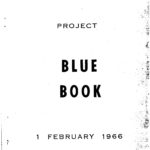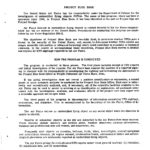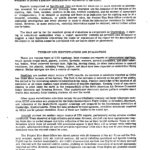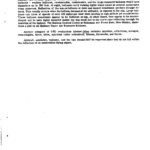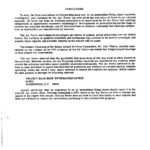

News
US Department of Defense documents reveal wormholes and extra dimensions research
As part of a US Department of Defense (DoD) project named the Advanced Aerospace Threat Identification Program (AATIP), the US government funded research involving wormholes and extra dimensions, according to documents released Wednesday in response to a Freedom of Information Act (FOIA) filed in August 2018. A communication addressed to Senators John McCain and Jack Reed, then-chair of the Senate Committee on Armed Services, provided a list of 38 research papers produced under the program, the titles of which indicated several surprising topics. The research disclosed indicates that the government is just as interested in the application of fantastic sounding technologies as science fiction creators and aficionados.
UPDATE: The correspondence to Senators McCain and Reed was first released to former Deputy Director in the UK’s Directorate of Defense Security, Nick Pope, by the US Defense Intelligence Agency’s Office of Corporate Communications on January 16, 2018. An article published in The Guardian in October last year written by Mr. Pope described his interest in the paper’s release after noting a DIA briefing on AATIP given to a Congressional committee in April according to the Congressional Record. The FOIA request was sought and obtained separately from Mr. Pope’s efforts.
Some of the titles of the publications produced with AATIP funding included:
- Invisibility Cloaking, by Dr. Ulf Leonhardt of Univ. of St. Andrews
- Traversable Wormholes, Stargates, and Negative Energy, by Dr. Eric Davis of EarthTech International
- High-Frequency Gravitational Wave Communications, by Dr. Robert Baker, GravWave
- Antigravity for Aerospace Applications, Dr. Eric Davis, EarthTech International
- Concepts for Extracting Energy from the Quantum Vacuum, Dr. Eric Davis, EarthTech International
- An Introduction to the Statistical Drake Equation, Dr. Claudio Maccone, International Academy of Astronautics
- Space-Communication Implications of Quantum Entanglement and Nonlocality, Dr. J. Cramer, Univ. of Washington
The research indicated may seem unusual for a government program, but AATIP’s $22 million dollar purpose, the existence of which was first reported by the New York Times in 2017, was to investigate foreign advanced aerospace weapons threats. Thus, studies into technologies that have years of development to go before having direct applications would be within the scope of the investigation.
The invisibility cloaking, for example, is based on optical illusions achieved through light manipulation which a foreign entity could utilize in some fashion, and a quick Google search of the report’s author, Dr. Ulf Leonhardt, will lead you to his TED Talk explaining the technology. EarthTech International, the institute responsible for some of the more fictional-sounding technology research, is an organization dedicated to exploring theories and topics as they may apply to develop innovative propulsion and energy sources, most of the members of which have PhDs and backgrounds in theoretical and experimental physics. In other words, the topics are well known in the science community, and the DoD is interested in knowing if there are security threats involving their applicability.
- A summary of the Air Force’s Project Blue Book. | Credit: US Department of Defense/US Air Force
- A summary of the Air Force’s Project Blue Book. | Credit: US Department of Defense/US Air Force
- A summary of the Air Force’s Project Blue Book. | Credit: US Department of Defense/US Air Force
- A summary of the Air Force’s Project Blue Book. | Credit: US Department of Defense/US Air Force
- A summary of the Air Force’s Project Blue Book. | Credit: US Department of Defense/US Air Force
The background of AATIP is perhaps a bit more interesting to the conspiracy-minded than the research topics provided to Congress. The program began in 2007 and supposedly ended in 2012, although that claim is disputed by the program’s DoD participants. Its initiator was former Senator Harry Reid of Nevada, whose longtime interest in space phenomena is well known in the UFO community. Robert Bigelow – the same man whose Bigelow Aerospace company has successfully installed an expandable module on the International Space Station in 2016 – received a majority of AATIP’s funding to study UFO reports. Bigelow is also well-known in the UFO community for his belief in alien Earth visitation. AATIP isn’t the first known expenditure by the US government on unusual technology – the Air Force’s Project Blue Book (1952-1969) investigated similar phenomena and is currently the subject of a History Channel dramatization by the same name.
UPDATE: Mr. Pope, whose background includes a post at the UK Ministry of Defense’s Secretariat (Air Staff) division where he mirrored the type of work done by Project Blue Book, has provided Teslarati with further context for the revealed AATIP research:
“…I’ve been quoted in various media articles discussing the letter I obtained, but wanted to address the main question I’ve been asked, concerning what this new revelation tells us about the true nature of AATIP. The letter describes the AATIP program as being one looking at next-generation aerospace threats. That’s been the way the DOD and DIA have spun this story from day one. Skeptics of some of the more exotic claims made about AATIP say this isn’t spin at all, but an accurate description of the program. Fair enough, but people should also bear in mind that Harry Reid described the program in similar terms in his June 24, 2009 letter to William Lynn III, and Reid has been very clear that yes, AATIP looked at UAP [Unidentified Aerial Phenomena]…People won’t get a definitive answer…unless and until further AATIP paperwork is released.” – Nick Pope, January 2, 2019
The FOIA request revealing the AATIP research papers was filed by Steven Aftergood, director of the Federation of American Scientists’ Project on Government Secrecy, a group dedicated to promoting public access to national security information. It regularly makes FOIA requests for the public’s benefit within this realm and also publishes government documents otherwise undisclosed or hard-to-find related to public or intelligence policy. A visit to the group’s website will provide links to their work through multiple presidential administrations and resource links for anyone interested in delving further into government secrets.

Elon Musk
Elon Musk’s xAI closes upsized $20B Series E funding round
xAI announced the investment round in a post on its official website.

xAI has closed an upsized $20 billion Series E funding round, exceeding the initial $15 billion target to fuel rapid infrastructure scaling and AI product development.
xAI announced the investment round in a post on its official website.
A $20 billion Series E round
As noted by the artificial intelligence startup in its post, the Series E funding round attracted a diverse group of investors, including Valor Equity Partners, Stepstone Group, Fidelity Management & Research Company, Qatar Investment Authority, MGX, and Baron Capital Group, among others.
Strategic partners NVIDIA and Cisco Investments also continued support for building the world’s largest GPU clusters.
As xAI stated, “This financing will accelerate our world-leading infrastructure buildout, enable the rapid development and deployment of transformative AI products reaching billions of users, and fuel groundbreaking research advancing xAI’s core mission: Understanding the Universe.”
xAI’s core mission
Th Series E funding builds on xAI’s previous rounds, powering Grok advancements and massive compute expansions like the Memphis supercluster. The upsized demand reflects growing recognition of xAI’s potential in frontier AI.
xAI also highlighted several of its breakthroughs in 2025, from the buildout of Colossus I and II, which ended with over 1 million H100 GPU equivalents, and the rollout of the Grok 4 Series, Grok Voice, and Grok Imagine, among others. The company also confirmed that work is already underway to train the flagship large language model’s next iteration, Grok 5.
“Looking ahead, Grok 5 is currently in training, and we are focused on launching innovative new consumer and enterprise products that harness the power of Grok, Colossus, and 𝕏 to transform how we live, work, and play,” xAI wrote.
Investor's Corner
Tesla gets price target bump, citing growing lead in self-driving

Tesla (NASDAQ: TSLA) stock received a price target update from Pierre Ferragu of Wall Street firm New Street Research, citing the company’s growing lead in self-driving and autonomy.
On Tuesday, Ferragu bumped his price target from $520 to $600, stating that the consensus from the Consumer Electronics Show in Las Vegas was that Tesla’s lead in autonomy has been sustained, is growing, and sits at a multiple-year lead over its competitors.
CES 2026 validates Tesla’s FSD strategy, but there’s a big lag for rivals: analyst
“The signal from Vegas is loud and clear,” the analyst writes. “The industry isn’t catching up to Tesla; it is actively validating Tesla’s strategy…just with a 12-year lag.”
The note shows that the company’s prowess in vehicle autonomy is being solidified by lagging competitors that claim to have the best method. The only problem is that Tesla’s Vision-based approach, which it adopted back in 2022 with the Model 3 and Model Y initially, has been proven to be more effective than competitors’ approach, which utilizes other technology, such as LiDAR and sensors.
Currently, Tesla shares are sitting at around $433, as the company’s stock price closed at $432.96 on Tuesday afternoon.
Ferragu’s consensus on Tesla shares echoes that of other Wall Street analysts who are bullish on the company’s stock and position within the AI, autonomy, and robotics sector.
Dan Ives of Wedbush wrote in a note in mid-December that he anticipates Tesla having a massive 2026, and could reach a $3 trillion valuation this year, especially with the “AI chapter” taking hold of the narrative at the company.
Ives also said that the big step in the right direction for Tesla will be initiating production of the Cybercab, as well as expanding on the Robotaxi program through the next 12 months:
“…as full-scale volume production begins with the autonomous and robotics roadmap…The company has started to test the all-important Cybercab in Austin over the past few weeks, which is an incremental step towards launching in 2026 with important volume production of Cybercabs starting in April/May, which remains the golden goose in unlocking TSLA’s AI valuation.”
Tesla analyst breaks down delivery report: ‘A step in the right direction’
Tesla has transitioned from an automaker to a full-fledged AI company, and its Robotaxi and Cybercab programs, fueled by the Full Self-Driving suite, are leading the charge moving forward. In 2026, there are major goals the company has outlined. The first is removing Safety Drivers from vehicles in Austin, Texas, one of the areas where it operates a ride-hailing service within the U.S.
Ultimately, Tesla will aim to launch a Level 5 autonomy suite to the public in the coming years.
Elon Musk
Elon Musk’s Biggest Revelations on AI, Robots, and the Future of Work from the Moonshots Podcast

Elon Musk’s appearance on the Moonshots with Peter Diamandis podcast was packed with bold predictions, candid admissions, and surprising tech insights. The nearly three-hour conversation covered everything from artificial intelligence to humanoid robots, geopolitics, and the future of work. Here are the top 10 most intriguing takeaways:
-
Aggressive AGI Timeline Predictions
Musk offered a detailed view on when artificial general intelligence (AGI) could emerge, suggesting it may arrive sooner than many expect, emphasizing both transformative potential and risks.
-
U.S. vs. China in the AI Race
He discussed the strategic competition between the United States and China over AI development, noting that geopolitical dynamics will shape how and who leads in the next decades.
-
Future of Job Markets
Musk touched on how AI and automation could reshape employment, predicting massive boosts in productivity alongside potential disruptions in traditional work structures.
-
Clean Energy Transition
A recurring theme was the role of clean energy in future economies, with Musk reiterating the importance of scaling sustainable power generation and storage.
-
Humanoid Robots Are Coming
On the podcast, Musk elaborated on Tesla’s work on humanoid robots, hinting at timelines and applications that go beyond factories to general-purpose assistance.
-
Tesla Roadster “Last Human-Driven Car”
Outside the core discussion topics, Musk teased features of the upcoming Tesla Roadster — calling it “the best of the last of the human-driven cars” and suggesting safety won’t be its main selling point.
-
The Role of AI in Clean Energy and Robotics
Linking AI to both energy optimization and robotics, Musk explained how smarter systems could accelerate decarbonization and task automation across industries.
-
U.S. Innovation Leadership
Musk argued that maintaining American leadership in key tech sectors like AI, space, and robotics should be a national priority, with thoughtful policy and investment.
-
Job Creation vs. Job Elimination
While acknowledging automation’s disruptive effects, he also outlined scenarios where new industries and opportunities could emerge, particularly in AI, space, and advanced manufacturing.
-
Long-Term Vision for Humanity
Throughout the conversation, Musk revisited his long-term philosophical views — including a belief in humanity’s responsibility to become a multi-planetary and technologically empowered species.
Whether you agree with Musk’s optimism or not, the podcast offers a window into the thinking of one of the most influential figures in tech today, in and why his visions continue to spark debate and inspiration.
